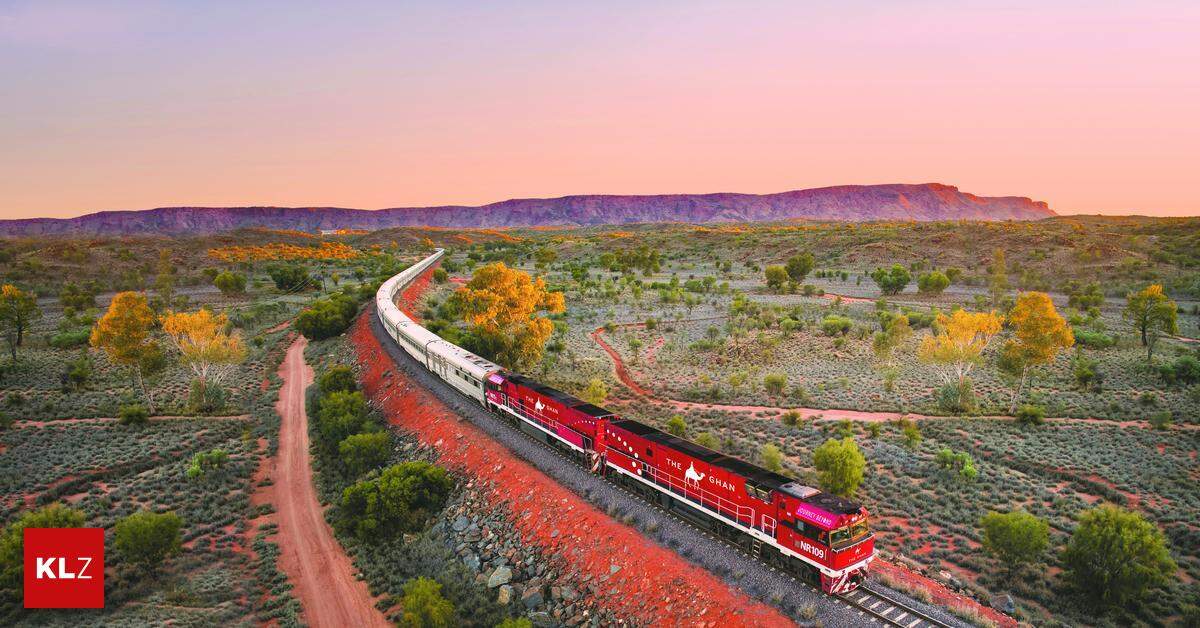One of the most remote regions on earth passes by outside the train windows, while inside Bloody Marys and fine wines are served. While cocktails are mixed in the lounge bar, guests let their gaze wander over the uninhabited expanses of the Australian outback. They know that they are making a lifelong dream of many globetrotters come true: to cross Australia from end to end on “The Ghan”.
The legendary train, which recently celebrated its 95th birthday, connects the southern metropolis of Adelaide in South Australia with Darwin in the tropical Top End of the Northern Territory. That is 2,979 kilometers, mostly through no man’s land, including the “Red Centre” with its world-famous red soil.
A truly monumental trip. Or as the operator “Journey Beyond Rail” puts it somewhat boldly: “The Ghan promises access to parts of Australia that no other holiday can offer – the perfect balance between comfort and adventure.” In fact, when you look out over the barren and at the same time breathtaking infinity of the outback, you can’t help but feel like you’re completely lost here, alone.
The route of “The Ghan” through Australia © dpa-infografik GmbH
You might also be interested in this video
Longest passenger train in the world
Including several stops and excursions – for example to the opal capital Coober Pedy or to Nitmiluk National Park with its high sandstone cliffs – the entire trip takes four days and three nights. Partial sections can also be booked, which makes the expensive undertaking a little more affordable.
“When fully occupied, the train is almost a kilometer long, making it the longest passenger train in the world,” says Journey Manager Tom Borthwick. Up to 50 employees look after the well-being of a maximum of 220 guests. There are also technicians on board to immediately solve any power outages in the middle of the wilderness or other problems.
Apart from the cabins and suites and the aforementioned lounge, there is the “Queen Adelaide” restaurant and another one specifically for the Platinum class, which offers double the cabin size. Fine cuisine with selected menus is a trademark of the “Ghan” – from crocodile dumplings made from real crocodile meat to grilled barramundi.
Also typical: the vintage charm of bygone railway days, which the wood paneling and even the smallest details exude – from the delicate door handles to the panoramic windows trimmed to look old to the leather armchairs in the lounge. Despite all this, the amenities of the 21st century are not neglected. “The Ghan” is a luxury train.
Many non-fiction books, as well as novels such as Judy Nunn’s “Spirits of the Ghan”, have been written about the rolling legend. “It’s a slow, soothing, timeless world that’s more like a cruise than a train journey,” enthuses Michael Frayn in “The Ghan. Great Train Journeys of the World”.
When camels conquered the outback
The iconic bright red locomotive pulls an average of between 30 and 40 silver-colored stainless steel carriages through the country like a gigantic snake. Each compartment car bears the words “The Ghan” with a camel logo in the middle. The animals, which don’t really fit in Down Under, play an important role in the history of the long-distance train. Especially when it comes to its curious name.
The continent’s first camel arrived by ship from the Canary Islands and landed on Australian soil in Adelaide in 1840. In the decades that followed, these undemanding pack animals were used primarily for expeditions into the interior of the country and for the development of remote regions.
When the trans-Australian telegraph line was built in 1872 to connect Port Augusta with Darwin, it was camels that transported the building materials and food. “Even the massive piano was dragged here on a camel’s back – just imagine,” says German Cella Livingston, who runs the old telegraph station in Alice Springs, where the instrument still stands today.
How “The Ghan” got its name
The camel drivers were generally called Afghans, although most of them did not come from the area of present-day Afghanistan, but from other countries in the Middle East. Their caravans were again indispensable when the first tracks for the planned railway were laid northwards in 1878.
“How exactly the train got its famous nickname will probably never be fully explained,” reads a commemorative plaque at Alice Springs train station, next to which stands a camel sculpture. In its illustrious history it has been called “The Afghan Express,” “The Afghan Special,” and “The Royal Ghan.” In the end, the simple name “The Ghan” prevailed.
On August 4, 1929, the first train left Adelaide with 100 passengers heading for the small town of Stuart, now known as Alice Springs. For a long time, this was the final stop for travellers on the Gahn. The 1,420-kilometre-long second half of the route to the north has only been in operation since 2004.
“What I love most about my job is that this is a real dream trip for the guests and I can be part of making it happen,” says Caitlin Hill. The 25-year-old works in service and is currently mixing a Bloody Mary behind the bar in the lounge.
Meanwhile, the guests look out of the windows, spellbound, at the red earth and the endless expanse of Australia, where termite mounds, spinifex grasses and colorful desert flowers pass by in time with the rattling train. Then night falls and the passengers make themselves comfortable in their white-covered beds. But “The Ghan” continues to travel through this ancient land, illuminated only by the Milky Way and millions of stars.


